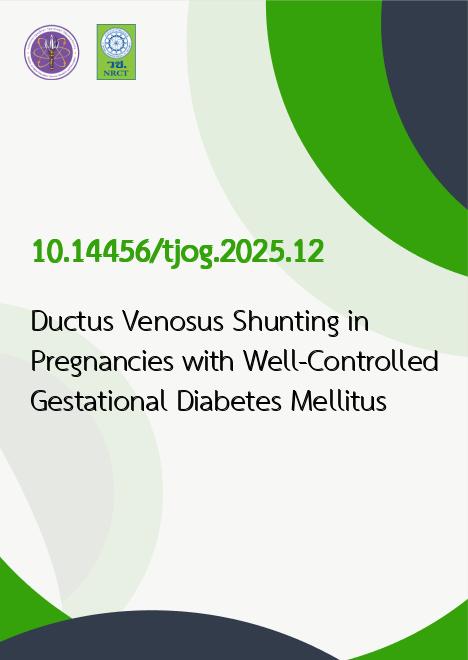
|
Ductus Venosus Shunting in Pregnancies with Well-Controlled Gestational Diabetes Mellitus |
|---|---|
| รหัสดีโอไอ | |
| Creator | Puntabut Warintaksa |
| Title | Ductus Venosus Shunting in Pregnancies with Well-Controlled Gestational Diabetes Mellitus |
| Contributor | Wirada Dulyaphat, Sommart Bumrungphuet |
| Publisher | PIMDEE Co., Ltd. |
| Publication Year | 2568 |
| Journal Title | Thai Journal of Obstetrics and Gynaecology |
| Journal Vol. | 33 |
| Journal No. | 2 |
| Page no. | 104-116 |
| Keyword | Doppler sonography, fetal circulation, fetal ultrasonography |
| URL Website | https://tci-thaijo.org/index.php/tjog/index |
| Website title | www.tci-thaijo.org |
| ISSN | 2673-0871 |
| Abstract | Objectives: Gestational diabetes mellitus (GDM) is a common metabolic disorder in pregnancy, and it can be identified in 20% to 25% of Southeast Asian pregnancies. For GDM, fetal hypermetabolic rate due to hyperinsulinemia may cause an increase in hepatic blood flow from the umbilical venous (UV), leading to a decrease in ductus venosus (DV) shunting. The objective of this study was to compare DV shunting between uncomplicated pregnancy and gestational diabetes mellitus.Materials and Methods: A prospective cohort study was performed on 76 women with uncomplicated singleton pregnancies and 36 women with GDM. Ductus venosus flow (DVF) and umbilical venous flow (UVF) were measured to assess the degree of DV shunting at 28-32 weeks of gestation. Pregnancy and neonatal outcomes were also collected and analyzed, including antenatal complications, gestational age at delivery, birth weight, Apgar score, neonatal intensive care unit (NICU) admission, ventilator support, and neonatal morbidity. Results: The baseline characteristics of both groups were not significantly different, except for mean maternal age. There was no difference in the degree of DV shunting between the GDM and the control groups after adjustment for maternal age and gestational age, 41.34 % vs 40.18 %, respectively (p = 0.70). After multiple linear regression analysis, DVF, UVF, and DV shunting with an adjustment for maternal age and gestational age (GA) did not show a statistically significant difference. No relationships were found between the hemodynamic variables and perinatal outcomes. Conclusion: This study suggested that good control of maternal GDM may prevent an increase in fetal hepatic blood flow, as indicated by no significant change of DV shunting and UVF. |
